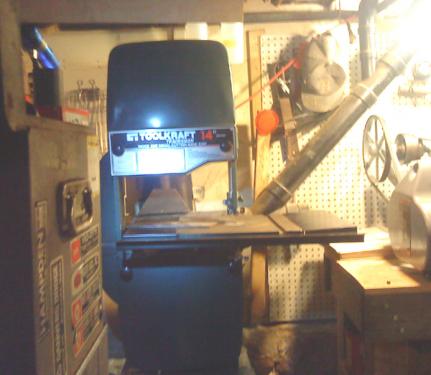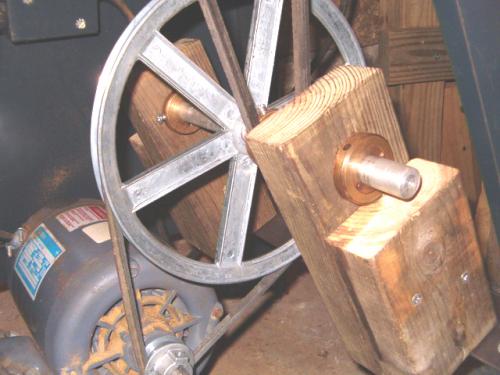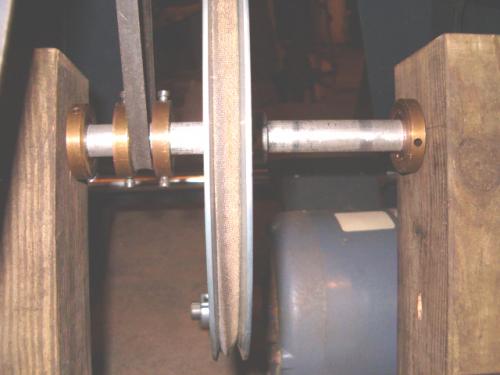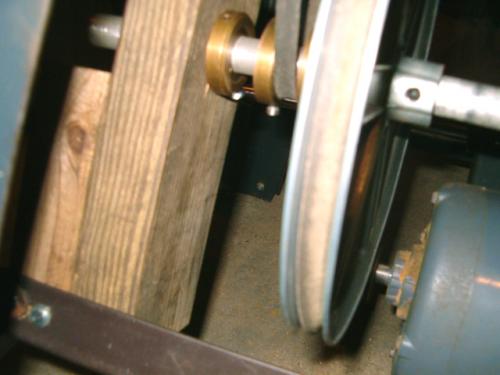06-18-2015, 10:16 PM
(This post was last modified: 06-18-2015, 10:20 PM by Charles Spencer.)
Well, I took a different and somewhat more comical approach with my Toolkraft (of Springfield, Massachusetts) 14" bandsaw. I used pulleys.
This what I posted somewhere at the time:
The saw in the first picture is a ToolKraft 14" Wood/Metal bandsaw. It was in good working order and clean when I bought it for $85.00. It doesn't look like it was ever used very much. It seems to be a copy more or less of the Delta Rockwell 28-200. Toolkraft was headquartered in Springfield and had a smaller plant in Enfield CT. It closed in 1984. This saw was made in Enfield.

I don't have a picture of the top pulley. Originally there was one belt that ran from the motor to the pulley running the wheels. That ran too fast to cut steel.

I added the large pulley and replaced the cone pulley on the motor with a 1 3/4" pulley, which was the smallest I could find. I created an Excel spreadsheet with the necessary formulas then ran it for different size pulleys. I got it down to 118 feet per minute.

I made an aluminum shaft from an old GP small pole. I mounted it through four brass bushings I had on hand. I made a support out of two pieces of 2"X4". About the largest wheel I could use was 10". To get the smallest diameter to drive the belt going to the saw I used the 3/4" shaft itself. The belt going to the saw runs between two additional bushings that each have two set screws...The 2"X4" supports are in turn supported by a cross piece I installed. I made it from a piece of iron bed frame. I have it attached to the saw frame with one bolt on each side. These are set up to provide tension adjustment to the second belt.

Charles
This what I posted somewhere at the time:
The saw in the first picture is a ToolKraft 14" Wood/Metal bandsaw. It was in good working order and clean when I bought it for $85.00. It doesn't look like it was ever used very much. It seems to be a copy more or less of the Delta Rockwell 28-200. Toolkraft was headquartered in Springfield and had a smaller plant in Enfield CT. It closed in 1984. This saw was made in Enfield.
I don't have a picture of the top pulley. Originally there was one belt that ran from the motor to the pulley running the wheels. That ran too fast to cut steel.
I added the large pulley and replaced the cone pulley on the motor with a 1 3/4" pulley, which was the smallest I could find. I created an Excel spreadsheet with the necessary formulas then ran it for different size pulleys. I got it down to 118 feet per minute.
I made an aluminum shaft from an old GP small pole. I mounted it through four brass bushings I had on hand. I made a support out of two pieces of 2"X4". About the largest wheel I could use was 10". To get the smallest diameter to drive the belt going to the saw I used the 3/4" shaft itself. The belt going to the saw runs between two additional bushings that each have two set screws...The 2"X4" supports are in turn supported by a cross piece I installed. I made it from a piece of iron bed frame. I have it attached to the saw frame with one bolt on each side. These are set up to provide tension adjustment to the second belt.
Charles
Charles Spencer, proud to be a member of MetalworkingFun Forum since Aug 2014.



